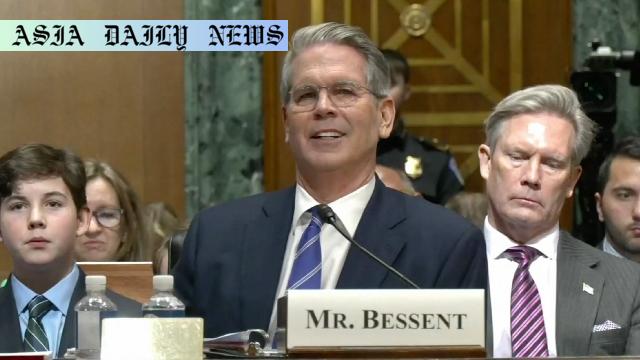Tariff Hike: US Treasury Secretary pushes for new universal tariffs on US imports beginning at 2.5% and increasing monthly.
Tariff Hike proposed by Treasury Secretary Scott Bessent to start at 2.5%.
Tariffs may rise monthly and reach a maximum rate of 20%.
Proposal provides nations opportunities to negotiate with the US.
Impact expected on global economies and markets.

Introduction to the Proposed Tariff Hike
US Treasury Secretary Scott Bessent has introduced a strategic economic initiative aimed at implementing a gradual increase in universal tariffs on imports. The plan proposes starting with an initial tariff of 2.5%, which would incrementally increase over time. This approach, as reported by the Financial Times, has the potential to reshape global trade relations while offering countries a window to negotiate terms favorably with the US administration.
Trump Administration’s Vision for Tariffs
The new tariff proposal aligns with US President Donald Trump’s broader vision to strengthen the US economy through strategic economic policy reforms. President Trump, known for his bold approach to international trade, supports this incremental tariff hike plan as a mechanism to address trade imbalances, boost domestic production, and incentivize fair trade practices globally.
Potential Structure and Timeline
The tariff structure, as it stands, suggests monthly increments that could push the rates up to 20% over time. According to sources quoted by the Financial Times, these increments are not arbitrary but part of a calculated strategy. The tiered increase allows the administration to assess the effectiveness of each increment and adjust based on feedback or negotiations from trading nations.
Impact on Global Economies and Trade Partnerships
If fully realized, the strategy could have significant ramifications for global trade. Countries with large export volumes to the US are likely to face economic pressures, compelling them to renegotiate trade agreements to mitigate the potential repercussions. Key industries such as automotive, electronics, and agriculture may witness shifts in supply chains and production strategies as they adapt to a more protectionist US trade policy.
Balancing Domestic Gains with Global Diplomacy
At its core, the tariff hike aims to bring more manufacturing back to US soil and curb the trade deficit. However, this move is not without risks. Critics argue it may strain international cooperation and trade relations, as well as increase costs for American consumers and businesses. The gradual progression of tariffs provides space for diplomacy, but the looming uncertainty around maximum tariffs could disrupt global confidence in the US as a trade partner.
Initial Reactions and Policy Implications
Responses to the tariff proposal have been mixed. Supporters highlight the initiative’s potential to benefit domestic manufacturers and reduce dependency on foreign goods. Meanwhile, opponents warn of retaliatory tariffs and economic volatility on a global scale. The outcome largely depends on the administration’s ability to balance national interests with global economic stability.
Conclusion: Walking a Fine Line
The proposed tariff hike underscores a critical pivot in US trade policy, echoing a protectionist stance while opening up negotiations. Whether this strategy succeeds hinges on effective diplomacy, robust economic planning, and adaptability to the evolving global trade landscape. As discussions within the administration continue, stakeholders around the world will keep a close watch on the unfolding developments.
Commentary
A Striking Shift in US Trade Policy
The proposal for a gradual, incremental tariff hike marks an interesting and bold shift in the US trade policy under the leadership of Treasury Secretary Scott Bessent. This initiative is no doubt ambitious, with significant implications for both domestic and global economies. By starting with a modest 2.5% tariff, the administration has left room for strategic adjustments while garnering enough leverage for negotiations with trading nations.
Global Impact: A Double-Edged Sword
The global economic ecosystem is intricately interconnected, and a policy of this magnitude holds the power to recalibrate international trade dynamics. While the US seeks to address its trade deficit and strengthen its manufacturing sector, nations heavily reliant on exports to the US may encounter economic difficulties. Industries, particularly in emerging economies, will feel the ripple effects, altering supply chains worldwide.
The Balancing Act
One commendable aspect of the plan is its gradual implementation. This creates an opportunity for nations and industries to adapt while leaving enough space for diplomatic negotiations. However, the uncertainty surrounding the eventual 20% tariff cap remains a potential destabilizer. Striking the right balance between national interests and international diplomacy will be crucial to the administration’s ability to pull this off without triggering a global trade war.
Final Thoughts
While the strategy appears ambitious and well-calculated on paper, its execution will reveal its true efficacy and impact. If handled with care and precision, this policy could successfully pivot the US economy into a stronger position while maintaining amicable relationships with key trading partners. On the other hand, any mismanagement could disrupt global trade stability. The next few months will undoubtedly be pivotal for policymakers, businesses, and global economies alike.


